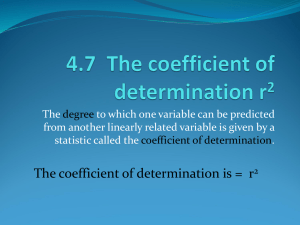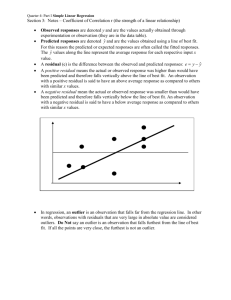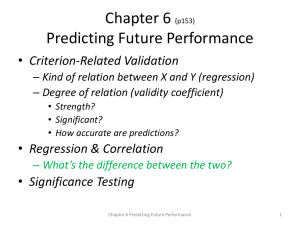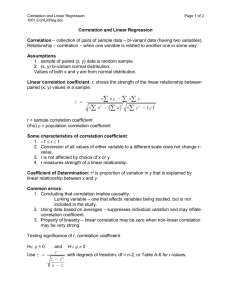NOTES on Pearsons Correlation Coefficient (r)
advertisement
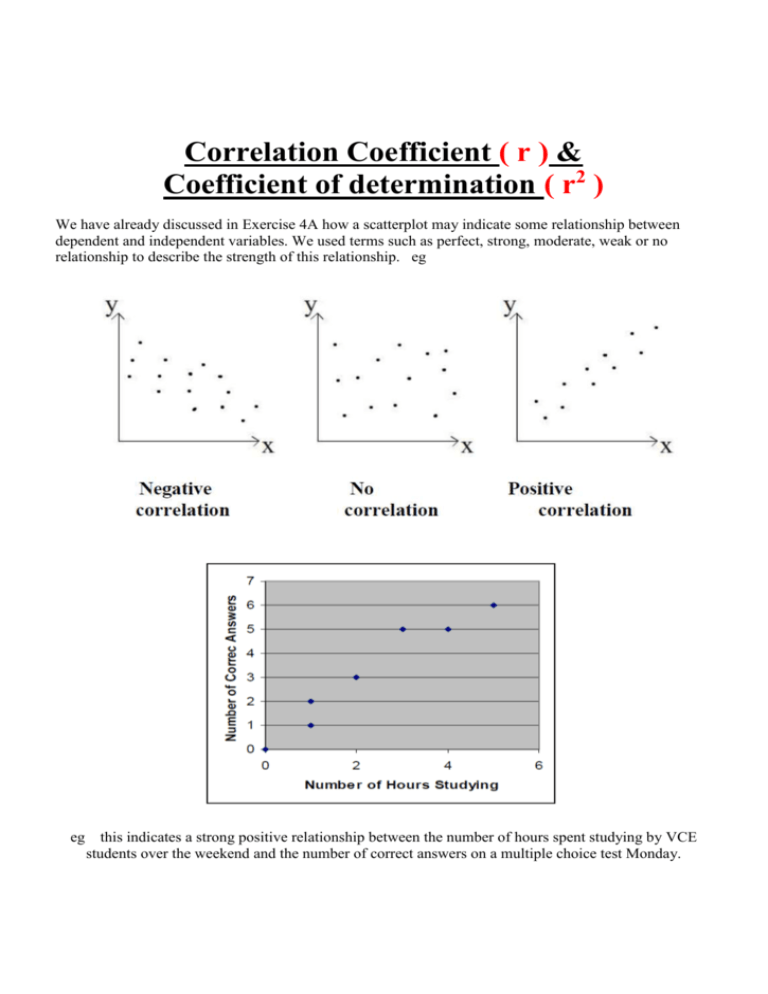
Correlation Coefficient ( r ) & Coefficient of determination ( r2 ) We have already discussed in Exercise 4A how a scatterplot may indicate some relationship between dependent and independent variables. We used terms such as perfect, strong, moderate, weak or no relationship to describe the strength of this relationship. eg eg this indicates a strong positive relationship between the number of hours spent studying by VCE students over the weekend and the number of correct answers on a multiple choice test Monday. eg 2 In this Psychology experiment, a university professor was aiming to establish some degree of negative relationship between heavy drinking by first year uni students and any measurable “intellectual impairment” by these students, under controlled conditions, on simple logic test. If we were to draw a line of best fit, either by eye ( the least accurate ), or using the two mean method or the least squares regression method on a calculator, you might end up with a line that looks like this. The equation of the line drawn is 𝒚 = −𝟏. 𝟓𝒙 + 𝟏𝟏. 𝟐𝟔 How well does the line represented by this regression equation truly represent the set of data? One of the ways to determine the answer to this question is to examine the correlation coefficient ( r ) and the coefficient of determination ( r2 ) These two numbers appear on your calculator when you enter the two sets of data in List A/ List B on your Classpad calculator. Lin Reg 𝒚 = 𝒂𝒙 + 𝒃 a =-1.520017 b= 11.124366 r = 0.712456 r2= 0.5041… The correlation coefficient, r, and the coefficient of determination, r 2 , will appear on the screen that shows the regression equation information Correlation Coefficient, r : The quantity r, called the linear correlation coefficient, measures the strength and the direction of a linear relationship between two variables. The linear correlation coefficient is sometimes referred to as the Pearson product moment correlation coefficient in honor of its developer Karl Pearson. There are several formulae for actually computing r. Three of these are: where n is the number of pairs of data. or GULP!!! Aren't you glad you have a graphing calculator that computes r for you? The value of r is always between -1 and 1 ( ie -1 ≤r ≤ +1 ) The + and – signs are used for positive linear correlations and negative linear correlations, respectively. Positive correlation: If x and y have a strong positive linear correlation, r is close to +1. An r value of exactly +1 indicates a perfect positive fit. Positive values indicate a relationship between x and y variables such that as values for x increases, values for y also increase. Negative correlation: If x and y have a strong negative linear correlation, r is close to -1. An r value of exactly -1 indicates a perfect negative fit. Negative values indicate a relationship between x and y such that as values for x increase, values for y decrease. No correlation: If there is no linear correlation or a weak linear correlation, r is close to 0. A value near zero means that there is a random relationship between the two variables. Note that r is a dimensionless quantity; that is, it does not depend on the units employed. A perfect correlation of ± 1 occurs only when the data points all lie exactly on a straight line. If r = +1, the slope of this line is positive. If r = -1, the slope of this line is negative. Examples r=1 a perfect +ve correlation r = 0 zero or no correlation r = -1, a perfect -ve correlation r = -0.55, a moderate –ve correlation r = 0.91, a strong +ve correlation Coefficient of Determination, r 2 The coefficient of determination, r 2, is useful because it gives the proportion of the variance (fluctuation) of one variable that is predictable from the other variable. It is a measure that allows us to determine how certain one can be in making predictions from a certain model/graph. The coefficient of determination is the ratio of the explained variation to the total variation. The coefficient of determination is such that 0 < r 2 < 1, and denotes the strength of the linear association between x and y. The coefficient of determination represents the percent of the data that is the closest to the line of best fit. For example, if r = 0.922, then r 2 = 0.850, which means that 85% of the total variation in y can be explained by the linear relationship between x and y (as described by the regression equation). The other 15% of the total variation in y remains unexplained. The coefficient of determination is a measure of how well the regression line represents the data. If the regression line passes exactly through every point on the scatter plot, it would be able to explain all of the variation. The further the line is away from the points, the less it is able to explain.

